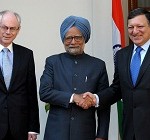On April 11, Prime Minister Manmohan Singh met Chancellor Angela Merkel in Berlin, Germany, to discuss collaborations between the two countries in education, science and technology, and climate change. The meeting was part of an ongoing series of negotiations between India and European Union (EU) countries on a free trade agreement (FTA).
With trade between India and EU at $91.3 billion 2010-2011 [1], this agreement can further strengthen economic ties and increase multilateral trade between India and the EU. The multi-pronged agreement covers industries such as pharmaceuticals, textiles, gems and jewellery, wines, and automobiles; it also includes the likelihood of increased foreign direct investment (FDI) by the EU in India’s insurance and defence sectors.
Progress on the FTA has so far been slow. Negotiations started in 2007 and the two sides have met more than 20 times in the last six years. Negotiation notes from 2009, 2010 and 2011 of this heavily-guarded agreement show that India will slash import tariffs on passenger cars, dairy items, and wines. The EU will return the favour by providing access to India’s textile, gems and jewellery markets. India is also negotiating easier visa processes for Indian citizens.
India is also discussing a ‘data-secure’ status for the country. So far, India is not considered data-secure by the EU; this obstructs the flow of sensitive data, such as information about patients, under data protection laws in the EU. The EU law mandates that European countries doing outsourcing business with countries that are not certified as data secure have to follow stringent contractual obligations, which increases operating costs and affects competitiveness.
While India is negotiating with the EU to open its doors to the Indian pharmaceutical industry, the EU has pushed for tighter intellectual property regulations for drugs sold in, as well as transported through, the EU. These regulations supersede Indian patent laws and go beyond the WTO’s agreement on TRIPS (Trade Related Intellectual Property Rights). This entails huge risks for the 300 large-to-medium sized Indian generic drug manufacturers. [2] It is a setback for the sunrise industry, which was waiting for patents on drugs worth over $171 billion to expire between 2011 and 2015. [3] The loudest noises of dissent are coming from this industry.
Indian automobile companies are also worried about a reversal of the smooth, policy-driven growth of the last few years. Slashing taxes on passenger cars to 10% from the comfortable, protectionist 100% and 150% on new and used cars respectively would flood the Indian market with imported cars. [4] [5] This would negatively impact manufacturing, investment and employment in India, and over time both local and foreign manufacturers are bound to experience slower growth.
On the other hand, the gems and jewellery, textiles, and leather industries are all eagerly anticipating the FTA to give greater access to European markets for their products. The extent of the boost is still unknown, but this is good news for industries on a slow growth track due to saturation.
FTAs have usually been signed between a developed economy (a supplier) and a developing economy (a market). The coupling between the two trading entities should promote business in fledgling industries on both sides. India plays its role of a developing nation with a young demographic, but many of the countries of the EU are struggling with crumbling economies, bankrupt financial institutions, and transitional or weak governments.
Moreover, the Indian beneficiary industries such as textiles, gems and jewellery are saturated and already amongst the top contributors to the country’s GDP. [6] [7] The trade diversion created by this FTA could also be harmful to industry in India. In the dairy industry, for example, the FTA would hand over supply to a non-efficient trading partner (heavily subsidised EU dairy products) from an efficient trading partner (domestic dairy products). For the automobile industry, cheaper imports would nullify all policy-driven measures that had prompted increased investment and production from domestic and international players.
But with the present anti-protectionist, pro-business stance of the Ministry of Commerce and Industry, the FTA is being championed with rigour and urgency. And Industry and Commerce minister Anand Sharma’s approval of increasing the defence FDI cap from 26% to 49% might actually be beneficial to India, which bought $12.7 billion in arms in 2007-2011. [8] Building manufacturing and testing capabilities in this sensitive industry would help India reduce its dependence on arms suppliers.
The FTA will be the first of India’s large trade agreements with a western bloc, with 27 economies. If structured well, the agreement can push India’s growth for the next decade. In fact, India could be looking at a long-term economic, political and military ally in the EU.
The impending elections in India as well as in Germany will play a major role in the progress and terms of the agreement. However, U.S President Barack Obama’s trip to Germany in June, where he is expected to discuss the much-anticipated Trans-Atlantic Trade and Investment Partnership treaty, might reduce the appeal for EU of a treaty with India. Meanwhile, the Indian and German governments have planned to meet again in New Delhi in May to iron out the differences.
References:
[1] European Commission, http://ec.europa.eu/trade/policy/countries-and-regions/countries/india/
[2] KPMG, http://www.in.kpmg.com/pdf/indian%20pharma%20outlook.pdf
[3] Express Pharma, http://pharma.financialexpress.com/sections/market-section/1592-adapting-to-the-evolving-consumer-landscape
[4] Central Board of Excise and Customs, Ministry of Finance, http://www.cbec.gov.in/customs/cst2012-13/chap-87.pdf
[5] Business Standard, http://www.business-standard.com/article/companies/eu-fta-domestic-auto-industry-fears-setback-in-manufacturing-competitiveness-113041600460_1.html
[6] MEA, Investment and Technology Promotion Division, http://www.indiainbusiness.nic.in/industry-infrastructure/industrial-sectors/gems-jewellery.htm
[7] MEA, Investment and Technology Promotion Division, http://www.indiainbusiness.nic.in/industry-infrastructure/industrial-sectors/textile.htm
[8] Economic Times, http://articles.economictimes.indiatimes.com/2013-04-18/news/38647023_1_defence-sector-defence-manufacturing-defence-equipment-industry
Deepak Rao is Senior Manager at Directi, where he manages business development for the company’s Media.Net business unit.
This blog was exclusively written for Gateway House: Indian Council on Global Relations. You can read more exclusive content here.
For interview requests with the author, or for permission to republish, please contact outreach@gatewayhouse.
© Copyright 2013 Gateway House: Indian Council on Global Relations. All rights reserved. Any unauthorized copying or reproduction is strictly prohibited.


